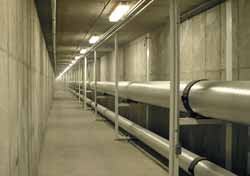Steam tunnels run a total of 1.2 miles below campus
Many Utah State University students don’t know they are walking 15 feet above hollow underground tunnels when they are traveling from class to class.
These tunnels house the pipes of the new central heating and cooling system. The system covers 1.2 miles of underground space and delivers steam for heat and chilled water for air conditioning to 29 buildings on campus.
Brian Andersen, director of facility operations, said a few students have been caught skateboarding inside the tunnel. But the tunnel operators are very strict on security issues because the high pressure steam in the tunnel can be hazardous.
“If there was to be a broken fitting, that steam is invisible and could really hurt someone,” he said.
Steam in the pipes has a pressure of 85 pounds per square inch and a temperature of about 325 degrees Fahrenheit, which can burn or even suffocate someone.
The old system ran off of coal.
“We were the biggest polluter in Cache Valley, by far,” Andersen said. “Initially, the old coal heat plant was letting off emissions of approximately 850 tons per year. The new natural gas plant is only letting off 135 tons per year.”
Reid Olsen, mechanical engineer at facilities operations at USU, said the university has been using coal boilers since the early 1900s. The old boilers were in “desperate need of replacement,” and the most recent ones had been around for 35 to 40 years.
“The emissions were the biggest reason to change,” Andersen said. “We wanted to do the right thing.”
Facilities employees proposed the new idea to the state. They showed them a life-cycle analysis and explained that it would save money in the long run if they switched to turbines.
“It ends up costing the university several hundred thousand dollars more, whereas it would cost millions more if we were still running on coal,” Andersen said.
The new pipes run almost everywhere, from the Nutrition and Food Science Building to the Chase Fine Arts Center to the Business Building to all of the buildings on the Quad. The system can produce 260,000 pounds of steam each hour.
“This is going to completely change the way we cool campus,” Andersen said. “By next spring, we’ll be generating chilled water.”
Currently, a chilled water line is being constructed between the Geology Building and the new Engineering Building. It will temporarily send chilled water from Old Main to the Engineering Building.
According to information from Facilities, by spring 2004, a new 850-ton chiller will be installed at the Central Energy Plant, and chilled water will be sent to the Engineering Building, Veterinary Science Building, Communicative Disorders Building, Campus Services and Biology and Natural Resources Building through the tunnel.
Soon, the tunnel will link Ray B. West, Family Life, Animal Science and Geology buildings to the large capacity chillers at some of the other buildings. All will be joined to the plant’s central chilled water.
The Central Energy Plant also plans on adding a co-generation unit that will provide approximately 50 percent of USU’s electrical power.
“We would be able to run many USU buildings and classrooms, even if Logan’s power went out,” Andersen said.
The tunnel project took just over 18 months from start to finish. It measures 10 feet by 10 feet and includes a 14-inch steam line and an eight-inch condensate line designed to accommodate future needs.
USU Facilities paid $23 million for piping and $14 million for the heat plant. The project totaled $41 million.
-karalcam@cc.usu.edu

